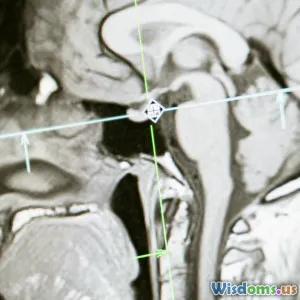
Neuroscience of Sleep: What Happens When We Dream
8 min read Explore the neuroscience behind dreaming and uncover what happens in our brains during sleep. (0 Reviews)
Neuroscience of Sleep: What Happens When We Dream
Dreaming has fascinated humanity for millennia, inspiring art, literature, and scientific inquiry. Yet, what truly unfolds in our brains when we dream remains a captivating mystery that modern neuroscience is steadily unraveling. From vivid stories painted by our imaginations to subtle subconscious processing, dreams represent a remarkable stage of brain activity during sleep that holds clues to memory, emotion, and mental wellbeing.
Unlocking the Enigma: Why Study Dreams?
Dreams are more than random images or mere entertainments of the sleeping mind. Neuroscientists have discovered that dreaming experiences correspond closely with specific brain activity oscillations and neural network behaviors. Understanding the neuroscience of dream formation helps illuminate how the brain integrates memory, processes emotions, and consolidates learning.
Moreover, dreams offer a unique window into psychiatric conditions. Abnormal dream patterns relate to disorders such as PTSD, depression, and schizophrenia. Thus, exploring what happens in the brain during dreams provides not only fundamental knowledge about consciousness but also paves the way for novel clinical interventions.
The Architecture of Sleep and Dreaming
Sleep consists of several stages, broadly split into Rapid Eye Movement (REM) and Non-REM (NREM) phases. Dreaming, especially vivid and emotionally poignant ones, predominantly occurs during REM sleep, which recurs cyclically about every 90 minutes in a typical sleep session.
What Is REM Sleep?
REM sleep is characterized by intense brain activity mimicking wakefulness: increased oxygen consumption, high-frequency, low-amplitude EEG waves, rapid eye movements, and muscle atonia (paralysis). This stage lasts longer toward the end of sleep cycles, roughly 10-30 minutes per REM bout.
During REM, the cerebral cortex, responsible for higher-order thinking and sensory processing, becomes highly active, while the prefrontal cortex—the region associated with logical reasoning and inhibition—shows reduced activity. This imbalance may explain why dreams are often illogical and surreal yet vividly colorful and arranged in complex narratives.
Dreams in NREM Sleep
Though REM sleep dominates dream research, studies show dreams can occur in NREM stages as well, though these tend to be more thought-like, less emotional, and less visual.
Brain Regions Engaged When We Dream
Neuroimaging and electrophysiological studies reveal that dreaming activates a network of brain areas. Core among these are:
- Visual Cortex: As dreams are highly visual experiences, this area lighting up during REM sleep explains the prominent imagery.
- Limbic System: Including the amygdala and hippocampus, this region handles emotions and memory formation, accounting for the often intense feelings and learned elements within dreams.
- Temporal and Parietal Lobes: These areas integrate sensory information and are implicated in the narrative structure and episodic components of dreams.
Interestingly, the diminished activity of the dorsolateral prefrontal cortex during dreaming impairs executive control and reality testing, contributing to the acceptance of bizarre dream scenarios without questioning their plausibility.
The Neurochemistry of Dreaming
The neurotransmitter environment also shifts dramatically during REM sleep:
- Acetylcholine levels surge, stimulating cortical activation and learning-related processes.
- Serotonin and norepinephrine drop to near zero, altering emotional regulation and vigilance.
This neurochemical cocktail creates a unique cerebral climate favoring internally generated experiences over external sensory input.
Why Do We Dream? Functions and Theories
The purpose of dreaming is still debated, yet several compelling hypotheses supported by neuroscience research exist.
1. Memory Consolidation and Learning
Emerging evidence ties REM sleep and dreaming to the consolidation of procedural and emotional memories. During sleep, especially REM, the hippocampus replays patterns of neuronal firing related to waking learning experiences, reinforcing synaptic strength and integrating information into long-term storage.
For example, a study published in Science (2004) demonstrated that people learning a virtual maze improved their performance after overnight sleep, with brain imaging showing hippocampal reactivation during REM.
2. Emotional Regulation and Problem Solving
Dreaming appears to provide a safe environment to process emotional experiences. Reduced prefrontal control during REM allows for free association and novel connections, which can help creative problem-solving and coping with stress.
Carl Jung considered dreams a direct window into the unconscious, where unresolved conflicts can present symbolically and be worked through. Modern research supports that dreaming modulates the amygdala and medial prefrontal cortex, contributing to mood regulation.
3. Why Do Dream Content and Themes Vary?
Dream content reflects personal experiences, ongoing concerns, and subconscious fears. Nightmares often emerge from trauma or anxiety, highlighting dreams’ potential role in threat simulation and rehearsing survival responses.
Disorders and Abnormalities of Dreaming
Dream disturbances can indicate neurological or psychological dysfunction.
- REM Sleep Behavior Disorder (RBD): Individuals act out dreams due to failure of normal muscle atonia. RBD often precedes neurodegenerative diseases such as Parkinson’s.
- Nightmares and PTSD: Frequent nightmares re-experience traumatic memories and disrupt restorative sleep, influencing emotional health.
These clinical insights emphasize why understanding the neuroscience of dreams matters beyond academic curiosity.
Conclusion: Dreaming as a Biological Marvel
Dreams are a dynamic interplay of neural activity, neurochemistry, and psychological processes embedded in the rich landscape of sleep. Neuroscience has unveiled many elements of this nightly journey—from the firing of specific circuits during REM sleep to the integration of memory and emotion, highlighting dreaming as a vital process rather than random aberration.
Yet, many questions remain open. What exactly triggers the content of dreams? Can we harness dreaming for enhanced creativity or healing? As neurotechnology advances, the next frontier beckons to decode the language of dreams further.
For anyone intrigued by the depths of the sleeping mind, the neuroscience of dreams offers a provocative glimpse into our brain’s ceaseless creativity, paving the path toward better mental health, memory, and understanding of human consciousness.
Rate the Post
User Reviews
Popular Posts




















